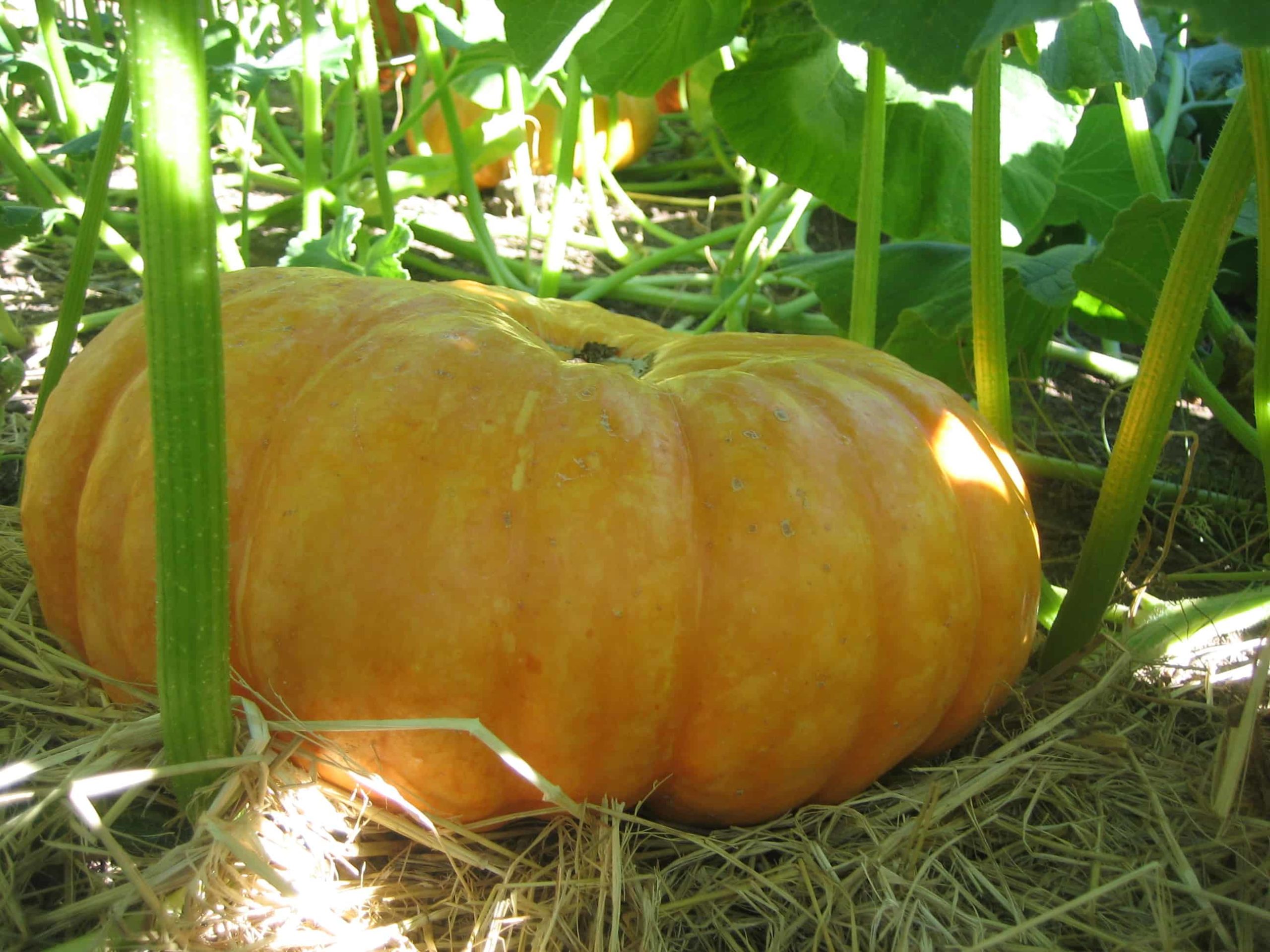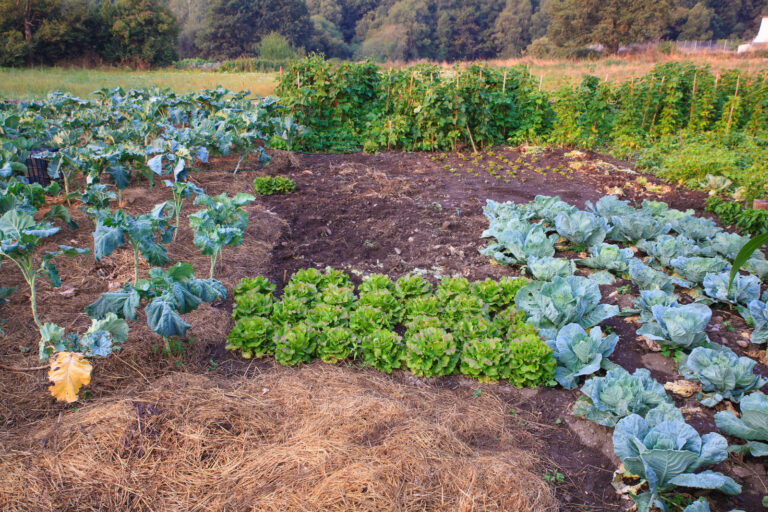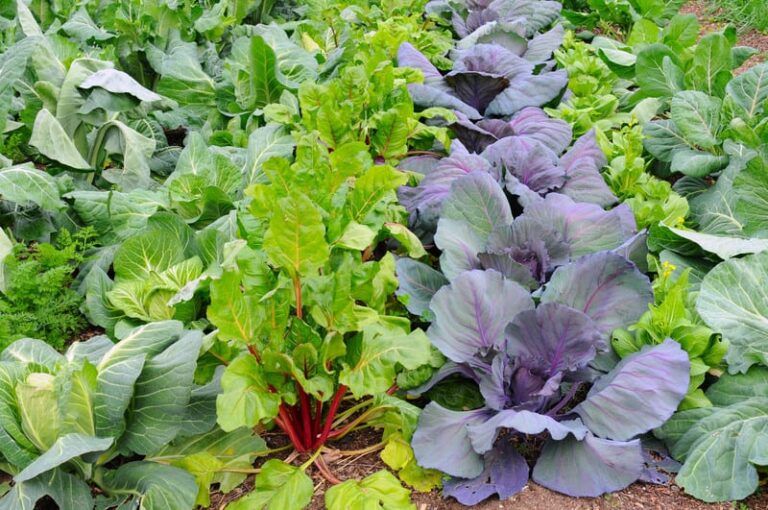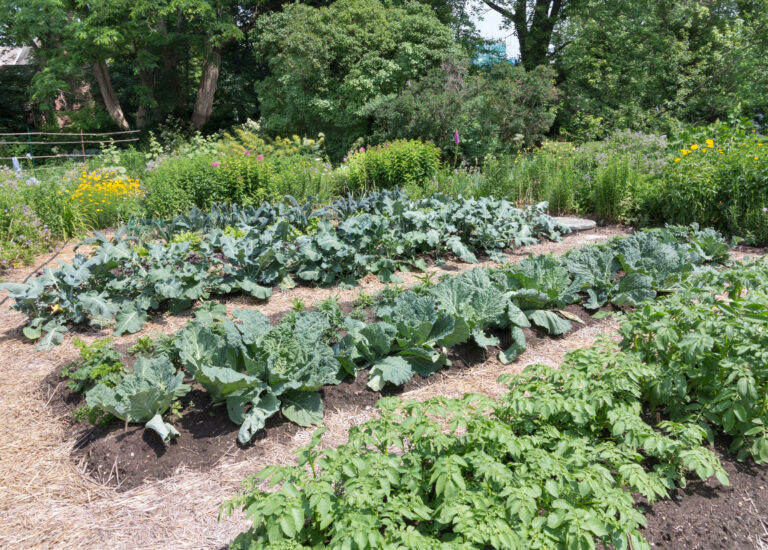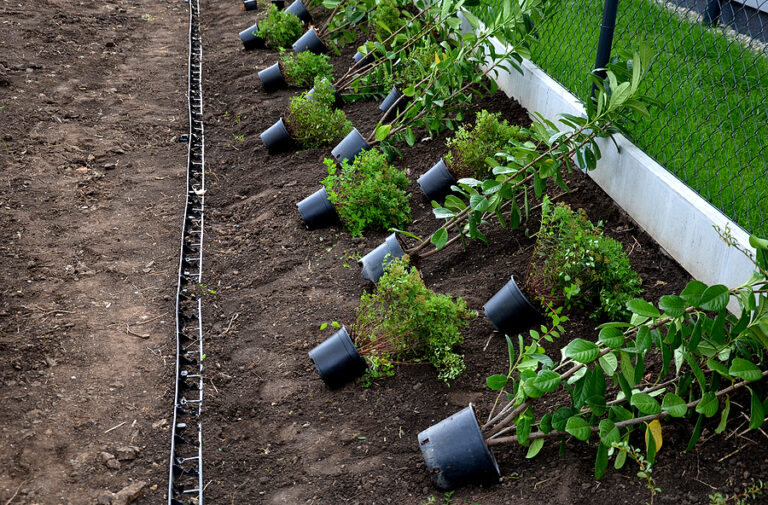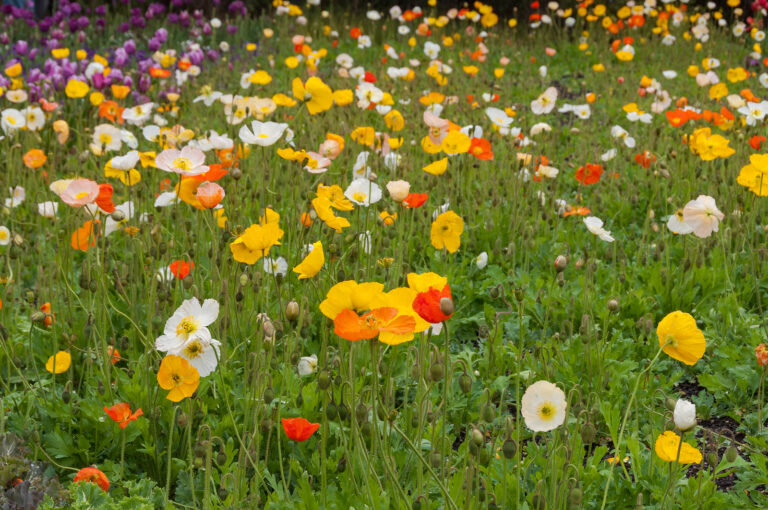October Vegetable Garden
Early October is the right time to begin thinking about the coming frost and cold weather. How will you extend the season if your summer crops are not yet ready for harvest? Many warm-weather crops and all cool-weather crops can withstand the first, second, or even third frost with a little protection.
Extending the season in autumn is different than opening the season in spring. Plants now are near maturity and the polyethylene tunnel or bell jar cloche that would keep a spring seedling safe might be too low and too small at this time of the year. But season extenders work the same in spring or fall; they raise the temperature undercover by several degrees allowing plants to carry on without weather-related setbacks.
If you don’t have a portable cold frame or plastic tunnel on hand, now is the time to fashion one or purchase one ready-made. Take a look first at the summer crops you would like to protect. Choose a tunnel or frame that is the right size to protect that crop. If you want to fashion and build your own, simply construct a frame over which you can place the polyethylene plastic sheeting (4ml) or horticultural cloth. (Some commercial fabrics will protect crops down to 20ºF.) After the summer crops are in, you can easily use the same protection to keep autumn and winter crops going well into the middle and even late winter.
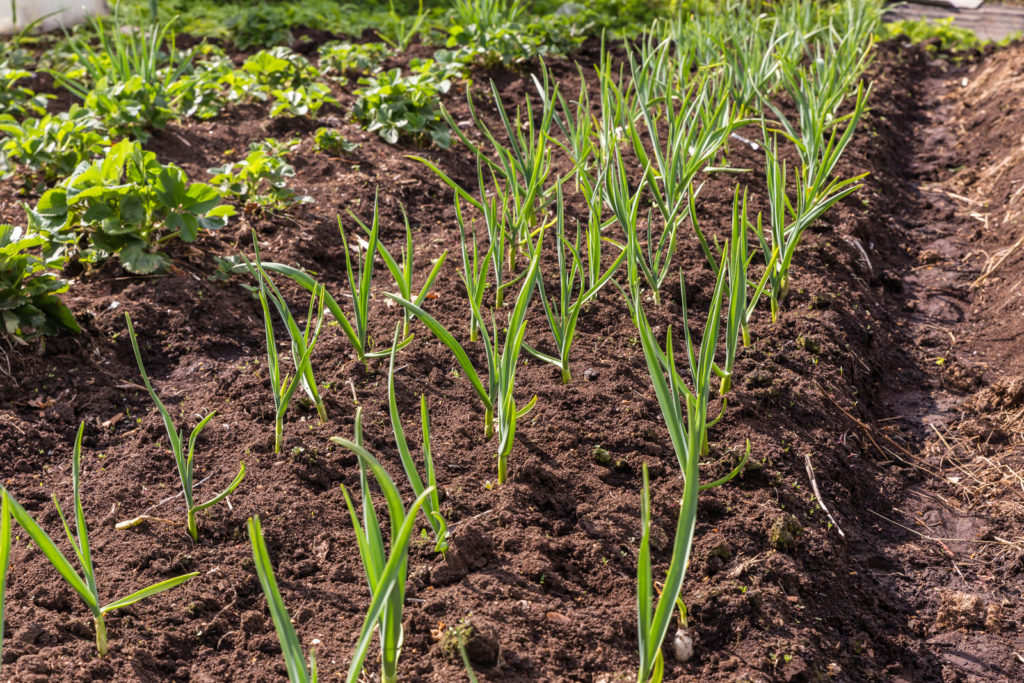
Planting in October
October is the month to store pumpkins and potatoes. Carrots and beets can stay in the ground until you are ready to take them to the table. Be sure to twist off their tops at harvest to avoid the loss of moisture which keeps them plump.
Protect cauliflowers from autumn winds, and remember that all cabbage family vegetables–cauliflower, broccoli, cabbage, Brussels sprouts–need consistent water this time of year. You can feed them with compost tea every two weeks to give them their final boost.
Continue to plant onions and broad beans through the fall, but be on the lookout for snails and slugs.
Here is a northern hemisphere planting list by region for October:
Cooler northern regions–Zones 3-6: Vegetables: broad beans, cress, leek, lettuce, onion, radish, shallots, spinach, spring onion, strawberry runners. Herbs: caraway, salad burnet.
Temperate Regions–Zones 7-9: Vegetables: artichoke suckers, broad beans, beet (beetroot), cabbage, Chinese cabbage, cress, leek, lettuce, mustard, onion, peas, radish, shallots, spinach, spring onion, strawberry runners, turnip. Herbs: angelica, caraway, chervil, chives, coriander, dill, lemon balm, marjoram, oregano, salad burnet, thyme.
Subtropical and Tropical Regions–Zones 10-12: Vegetables: beans, beet (beetroot), broad beans, broccoli, cabbage, cauliflower, celery, Chinese cabbage, cress, endive, lettuce, mustard, onion, spring onion, parsnip, peas, potato tubers, radish, rhubarb crowns, rutabaga (Swede), Swiss chard (silverbeet), tomato, turnip. Herbs: angelica, borage, caraway, celeriac, chervil, chives, coriander, dill, lemon balm, marjoram, oregano, parsley, salad burnet, thyme.
Regional tips for October
These suggestions are divided into 4 major geographical regions: North and East and Midwest (growing zones 2 in the northernmost regions to 6 along the coast), the South (zones 7 in the north to 10 in the far south), the Southwest and California (zones 7 in the coldest areas to zone 11 in the south), and the Northwest (zones 5 in the highest elevations to 8 along the coast.)
North and East and Midwest. Harvest remaining warm-season crops before the first frost: gourds, peppers, pumpkins, squashes, and tomatoes.
- Leave root crops in the ground until a serious freeze. Parsnips, salsify, and sunchokes can be left in the ground past the first few freezes; their flavor is improved by frost.
- Pull up tomato plants before frost, hang them by their roots to cellar or shed rafters and allow them to ripen.
- Top rhubarb crowns with an application of manure or compost.
- Clean the cold frame and line it with hay or straw.
- Close the season if you are not continuing in a cold frame or plastic tunnel: clean up weeds; compost discarded plants; work compost and green manure into beds.
- Add lime to the soil if it is acid.
- Remove tent caterpillars’ nests and cocoons.
South. Early this month in the cool Upper South, plant carrots, endive, kale, lettuce, radish, spinach, turnips, and onion sets. Plant beets, head lettuce, mustard, and radishes in the cold frame for winter use.
- Add compost to the soil and sow seed directly in a cold frame.
- In the Lower South, plant beets, broccoli, carrots, chard, Chinese cabbage, collards, cress, kale, kohlrabi, leaf lettuce, leeks, mustard, onion sets, parsley, radish, spinach, and turnips.
- Thin fall plantings of carrots, beets, and turnips when they are 3 to 4 inches tall.
Southwest and California. Check the first frost date for your area. You may still have time to plant cool-season crops this month for harvest before the first frost. There may be time to sow or plant beets, broccoli, Brussels sprouts, cabbage, carrots, cress, endive, kale, leek, Romaine and leaf lettuce, mustard, onions, parsnips, peas, potatoes, spinach, and turnips.
- Chinese edible pod peas can be trellised like sweet peas. Telephone peas and Windsor peas are excellent winter crops.
- Remove old plant stalks and leaves to eliminate the carrying over of pests and diseases from the summer garden.
- Be reminded that when temperatures drop below 50ºF plant growth will slow; when the temperatures drop to 40ºF and lower, the garden will approach dormancy.
Northwest. Cool-season crops can be planted this month if there are still enough days in your area before the first frost. Use the cold frame or plastic tunnels to extend the growing season. You will gain time if you set out transplants: late cabbage, cauliflower, Brussels sprouts, and broccoli. Radishes, lettuce, spinach, and yellow turnips for greens can be sown directly in the cold frame.
- Divide rhubarb clumps now.
- If you are not planting now, clean and close the garden for the season.
October harvest
Fresh fall pickings of greens and root crops start in October. Kale is approaching full maturity and cabbages are starting to slow down in their growth.
Now is the time to enjoy your final fresh pickings of tender squash. The first killing frost of the season is not far away.
First-of-season harvest: Chestnuts, kale, kiwi, persimmons, pomegranates, new walnuts.
Peak-of-season harvest: Apples, apple cider, apple cider vinegar, arugula, beets, broccoli, cabbages, carrots, cauliflower, chard, chilies, chipotles, cilantro, collards, dried fruit, green onions, guava (pineapple and strawberry), heirloom tomatoes, herb starts, leaf lettuce, leeks, lima beans, mushrooms, new potatoes, olive oil, onions, radishes, raisins, raspberries, red onions, rutabagas, salad mix, scallions, spinach, strawberries, sweet yellow onions, sweet potatoes, vegetable plant starts, fresh herbs including chives, dill, French tarragon, garlic chives, marjoram, parsley, rosemary, Russian tarragon, sage, oregano, and culinary bay leaves.
End-of-season harvest: Asian pears, basil, bell peppers, pickling and salad cucumbers, lemon cucumbers, eggplants, garlic, grapefruit, grapes, green beans, lemons, melons, nectarines, nopalitos, oranges, peaches, plums, raspberries, Romano beans, scallions, shelling peas, snow peas, strawberries, summer squash (Delicata, butternut, Kabocha, and acorn), table grapes, tomatillos, tomatoes, turnips, yellow waxed beans, winter vegetable starts, zucchini
Citrus will begin to ripen and be ready for harvest later this month. Apples and pears are coming to harvest now as well.
Here is a list of some of the vegetables and fruits that will come to harvest in October: Vegetables: beans, capsicum (sweet peppers), carrot, celeriac, chilies, Chinese cabbage, corn, cucumber, eggplant, kale, lettuce, melons, okra, peas, pumpkins, purslane, rutabaga (Swede), snow peas, spinach, summer squash, tomato, turnips, zucchini. Fruit: Granny Smith apples, avocadoes, banana, grapes, figs, feijoa, grapefruit, guava, lemons, limes, melons, olives, Valencia oranges, passionfruit, pecans, persimmon, pomegranate, quince, raspberries, strawberries, tamarilloes, walnuts.
Pick broccoli, cauliflower, cabbage, and kohlrabi as soon as they’re ready; protect these crops on cold nights.
- Carrots, beets, horseradish, parsnips, potatoes, and sunchokes can be stored in the garden all winter if the soil does not freeze; remove the tops and cover these vegetables with a foot of mulch.
- In areas where the ground freezes, lift root crops and store them in a frost-free place.
- Winter squash, sweet potatoes, and peanuts should be lifted, cured, and stored in temperatures between 50ºF and 60ºF.
- Cool-weather crops such as lettuce, Chinese cabbage, kale, and parsley can remain in the cold frame until ready to use; cover the frame on cold nights with blankets or straw mats.
- Pick outdoor tomatoes roots and all and ripen them by storing them upside down in a warm spot indoors, away from the frost.
Tips for October
Extend the season. Place cloches or plastic tunnels over kale, lettuce, parsley, spinach, and other low-growing vegetables allowing them to continue to grow with protection. Transplant young salad greens and herbs to a cold frame for later harvest. Protect outdoor tomatoes with fleece to extend their season. Protect late cauliflowers from frost by bending surrounding leaves over the heads. Heavily mulch carrots and other root crops are to be left in the garden.
Greenhouse. Clean and disinfect the greenhouse for winter use. Remove shading from greenhouse glass. Check heaters to make sure the minimum temperatures are being achieved. Ventilate whenever the weather is mild to avoid overheating within the greenhouse.
Herbs. Pot up annual herbs for winter use. Pot up roots of mint and force indoors for the winter supply. Mulch perennial herbs when the ground freezes.
Fruit trees. Pick and store apples and other tree fruit when ready. Rake and dispose of fallen leaves. Place mouse guards, chicken wire, or tar paper around the base of young trees to protect against winter rodents and rabbits. Wrap the trunks of young trees with tree tape or brush on white water-based paint to prevent sunscald. Apply tanglefoot or grease bands around the trunks of fruit trees to trap egg-laying insects, cankerworms, or inchworms. Plant fruit trees provided that the soil is not too wet or too cold. Prepare each hole by digging in plenty of organic matter such as garden compost. Prune back newly planted fruit trees immediately after planting. Water young trees deeply. Mulch trees 8-12 inches from the trunk. If you plan to plant trees early next spring, prepare the holes now before the ground freezes. Place leaves, straw, and burlap into and over the holes.
Bareroot fruit trees. Order bare-root fruit trees for delivery in late winter or early spring.
Berries. Prune blackberry, raspberry, loganberry, black and red and white currants, and gooseberries. Raspberry canes that fruited in the summer should be cut back to the soil level. New canes that did not fruit can be carefully tied into the support system. Take hardwood cuttings from grapevines, black currants, and gooseberries. Root them in sandy soil in a sheltered spot. Berries also can be layered (bury cane tips to 4 inches) to produce extra plants by spring. Plant berries from now until early spring provided that the soil is not too cold or too wet. Top dress new brambles with garden compost.
Strawberries. Cover late-fruiting strawberries with cloches if the temperature dips below 20ºF. Mulch strawberries but do not cover the crowns of strawberry plants. In warm-winter regions, set out new strawberry plants.
Citrus. Lightly fertilize citrus trees with compost or other organic fertilizer. Keep citrus well watered, but do not drown the roots.
Tomatoes. Mature tomatoes should be harvested just before frost. Wrap in paper and store in a cool dark place on shelves. Bring them out into a warm room two days before using.
Storage. Store rutabagas and turnips soon after cold weather. Cut off tops to a half-inch of root. Place on well-drained ground and cover with soil to prevent freezing.
Asparagus. Cut asparagus tops and put them on the compost heap after the first heavy frost. Top crowns with well-rotted manure or garden compost and good mulch.
Rhubarb. Divide rhubarb in late autumn. Rhubarb is a perennial and heavy feeder; mulch with garden compost or well-aged manure.
Compost. Spent plants from the garden can be added to the compost pile now. Now is the time to start a compost pile for next year’s use. Grass clippings, leaves, and any other organic matter can be added to the pile. A compost pile requires a thin layer of soil or aged cow or steer manure between each layer of green matter. Soil and manure will help the pile to decompose more quickly. Ensure all green matter, brown leaves, and woody material are well shredded before adding it to the compost pile. If you don’t have room for a compost pile, you can dig a compost pit and put leaves, clippings, and vegetable refuse in, along with a dressing of lime. Do not add animal fat or dairy products to the compost pile. Rich compost will be ready in about 9 months.
Sheet compost. Sheet compost is a mix of aged cow or poultry manure along with dry grass, straw, spoiled hay, and vegetable refuse that is layered on garden beds. After winter rains and snow, sheet compost is spaded into the garden in early spring.
Season close. Clean the garden of plant debris and weeds. This will ensure there is no place for pests and diseases to overwinter in the garden. Pest and disease-infected refuse should be burned or bagged and disposed of. Compost weeds that have not set seed along with other spent plants. Shred woody stalks before composting. If you are not using the cold frame this winter, clean out the frame and line the inside with dry leaves, hay, or straw. Close the sash and cover it with straw, aged manure, or earth. Take down stakes and trellises; clean and store them for next year. Clean and store tools and power equipment before storing them for the winter. Update your crop performance records.
Spring soil preparation. Fall is an excellent time to prepare the garden for spring. Add aged cow or horse manure or compost to the garden and turn it under. Leave rough clods exposed to sun, rain, frost, and snow during the winter. If you are planning a new or larger garden next spring, spade, plow, or break up the new ground now, add lime (to increase the soil pH) and aged manure (a week apart) if needed.
Cover crops. Plant winter cover crops if there is still time for the seed to germinate and grow. Cool-weather cover crops include vetch, Austrian winter peas, and burr clover.
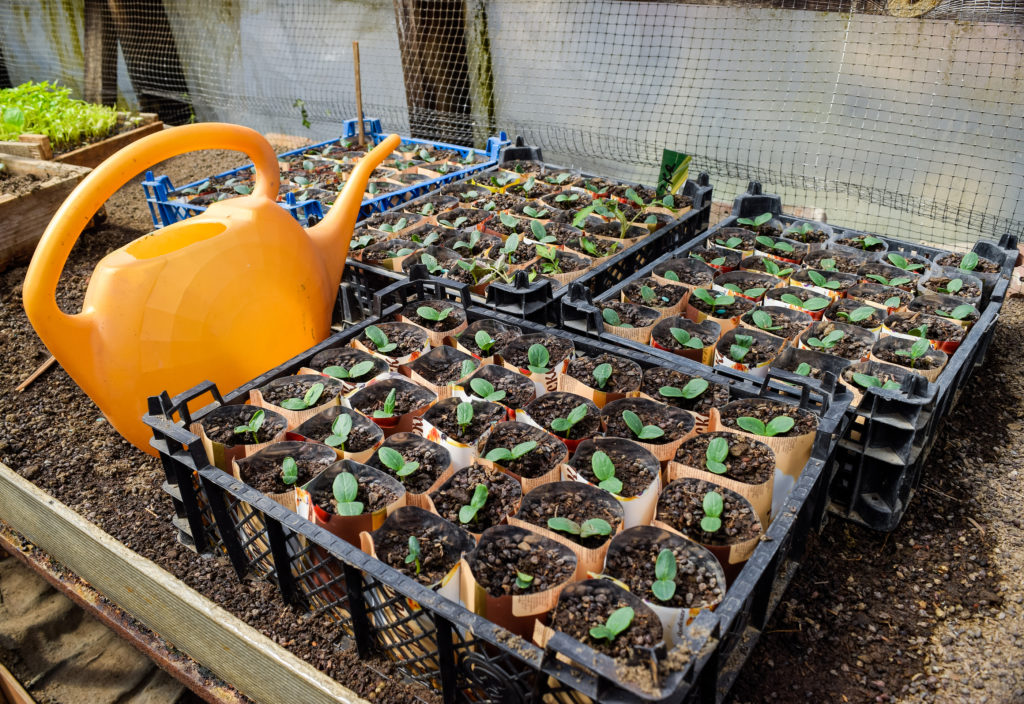
Southern Hemisphere garden in October
October is the month of greatest change in the southern hemisphere vegetable garden; spring is here.
Now is the time to plant with the summer reward in mind. Plant tomato, eggplant, capsicum, cucumber, sweet corn, marrow, melons, zucchini, and pumpkin this month in all but the coldest regions of the southern hemisphere.
Plant beets and radishes. Water them well and feed them with compost tea every two weeks going forward.
Plant salad mix and continue to plant them every two weeks for successive crops that you can begin to harvest in just a few weeks.
Plant cucumbers next to low walls or fences. Place pumpkins among corn to provide living mulch which will keep the soil cool and moist. Plant beans where they can begin to twist their way to the top.
Pile up extra straw and compost around potatoes as they begin their spring growth.
Place coddling moth traps in apple and pear trees now.
October planting in the Southern Hemisphere
Here is a planting schedule by region for the Southern Hemisphere in October:
Temperate regions: Vegetables: beans, beets (beetroot), cabbage, cape gooseberry, capsicum (sweet pepper), carrots, celery, celeriac, chicory, chayote (choko), chilies, cress, cucumber, eggplant, endive, leeks, lettuce, marrow (courgette), melons, mustard, spring onion, parsnip, peas, pumpkin, radish rhubarb crown, rosella, salsify, Swiss chard (silverbeet), squash, sweet corn, sweet potato, tomato, zucchini. Herbs: basil, borage, caraway, celeriac, chamomile, chervil, chicory, chilies, chives, coriander, dill, fennel, hyssop, lemon balm, oregano, parsley, salad burnet, thyme.
Tropical and subtropical northern regions: Vegetables: beans, beets (beetroot), buckwheat, cabbage, cape gooseberry, capsicum (sweet pepper), carrots, celery, celeriac, Chinese cabbage, choko (chayote), cress, cucumber, eggplant, fennel, lettuce, marrow, melons, mustard, okra, parsnip, peas, potatoes, pumpkin, radish, rhubarb crowns, rosella, silverbeet (Swiss chard), spring onion, squash, strawberry runners, sweet corn, sweet potato, tomato, zucchini. Herbs: basil, borage, caraway, chamomile, celeriac, chervil, coriander, dill, hyssop, lemon balm, marjoram, oregano, salad burnet, thyme.
Cooler southern regions: Vegetables: artichokes, beans, beet (beetroot), Brussels sprouts, cabbage, cape gooseberry, capsicum (sweet pepper), carrots, celery, celeriac, cress, cucumber, eggplant, endive, kohlrabi, leeks, lettuce, marrow, okra, spring onion, parsnip, peas, potato tubers, radish, rhubarb crowns, rutabaga (Swedes), salsify, Swiss chard (silverbeet), spinach, squash, sweet corn, tomato, zucchini. Herbs: basil, borage, caraway, celeriac, chamomile, chervil, chives, coriander, hyssop, lemon balm, oregano, parsley, salad burnet, thyme.
October harvest in the Southern Hemisphere
Here is a roundup of vegetables and fruits ready for harvest during October in the Southern Hemisphere: Vegetables: Artichoke, asparagus, beet (beetroot), broccoli, Brussels sprouts, cabbage, carrot, celeriac, celery, Chinese cabbage, lettuce, peas, Swiss chard (silverbeet), spinach. Fruit: Avocado, cape gooseberries, lemons, limes, mandarins, mango, mulberry, navel oranges, paw paw, raspberries, strawberries, tangelos.
More about October
The name October comes from the Latin word for eight, “octo”. October was the eighth month in the Roman calendar. That all changed in the sixteenth century when the Gregorian calendar was adopted. Now, October is the tenth month.
The whole reason for changing the calendar came with the notion of bringing the calendar into synch with the seasons of the year. Under the Roman calendar, the seasons from one year to the next weren’t always in sync. In other words, spring didn’t always arrive in March in the northern hemisphere and fall didn’t always arrive in October.
Well, these days October north of the equator means autumn. October is the month to finish the harvest and prepare for the first frost of autumn. October is the month when the sunshine grows hazy and the air grows tangy. The leaves change from crimson to russet, to gold, and the birds fly south.
Apples may still be on the tree in October and many grapes are still on the vine, but farmers are gathering their crops. Thanksgiving in Canada comes on the second Monday of October.
Indian summer also comes in October. There will be some warm days this month, but the nights are growing colder and insects that called the garden home will be gone with the first frost. Sparrows and other seed-eating birds are busy this month in fields and meadows collecting food for the winter.
Cosmos and calendula are the flowers for October. The last of the summer crops will come to harvest in October: tomatoes, eggplant, zucchini, cucumber, and corn.

